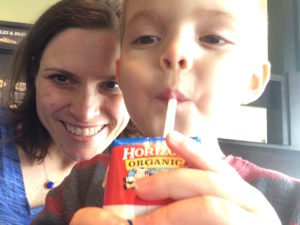Of all the questions I get asked about exercise and pregnancy, “the core” is one of the most common topics. Many women want to know if they can or should do core exercises while pregnant. What exercises should they be doing? What exercises should they be avoiding? How do they get their core back after having the baby? I chatted with my good friend, Lori Duncan, who is also a Physical Therapist specializing in biomechanical assessment and Pilates-based rehabilitation with transition to real-world movement and athletic exercises. I asked her some of the questions I most often am asked.
Why is it essential for women to work their core during pregnancy?
Having an active core during pregnancy allows the muscles around the pelvis and spine to appropriately respond and stabilize the area as it moves, expands and tilts during the 10 months of growth. Although the muscles are being slowly stretched (specifically the abdominals), it is important to keep them as strong as possible in that stretched position.
What are your top few core exercises for pregnant women?
My favorite cue/exercise for pregnant women is: “Hug your baby.” It is a cue that engages the inner two abdominal layers or what most people know as “the core”. It’s easy and can be practiced at work, in the car or lifting child number 1…or 2…3…you get the point.
What core exercises would you advise women to stay away from during pregnancy?
I wouldn’t say there are any exercises that are truly contraindicated, but some exercises just feel better than others. Crunches and planks can start to feel uncomfortable later in pregnancy, but that depends on the ability to engage the inner abdominal layers. When considering core exercises, be sure they feel safe and that you feel absolutely NO BACK PAIN.
Now let’s talk postpartum as so many women are anxious to get their core back.
After clearance from a women’s doctor to begin exercising again, how would you suggest a women starts working her core after pregnancy?
Train your abdominals in a neutral position. This can be on your back (supine) or hands and knees (quadruped). Master the ability to pull your belly in without moving ANY bones. It’s trickier than you think, but once you master that, everything else is cake! And, it prevents unnecessary low back pain.
Again, what exercises would you highly recommend?
It is important to start with smaller, stabilizing exercises to re-engage your body from the inside out. Once that is established after 3-4 weeks, then you can safely add in bigger, strength-training type movements.
Exercises:
- I love Pilates Bridging because it lengthens the back extensors that became tight during pregnancy WHILE training the intrinsic core. It’s an awesome exercise. Here is a link to a short video blog about finding the deep core again and Pilates Bridging: https://www.duncansportspt.com/2015/04/activate-the-core/.
- Side planks are a must! On your elbow and knees is a great way to start!
- Scapular training is key for posture and back pain. Some examples are rows and lat pulls with a resistance band. Yes, a resistance band. These bands give your body feedback about stability, which we need postpartum. Dumbbells don’t give our body the same feedback.
- Glutes! Glutes! Glutes! This does NOT mean squats. Clams, fire hydrants, Pilates side series are excellent ways to safely start training the glute muscles off the ground. Training muscles off the ground is an important starting place for healthy muscle activation.
What would you have them avoid post-pregnancy?
Crunches (unless you can do them with your deep core activated), heavy lifting and excessive high intensity classes. There is just no space for it. It took your body 10 months to have a baby, give it at least 10 months to regain some shape, stability and strength to return to back to “your normal.” The biggest mistake postpartum women make is pushing their body into an arena it’s not ready to participate. Carefully load the body over the ONE FULL YEAR postpartum to avoid injury, stress or pain to the body.
Can you explain a little bit about diastis recti, how to check for it and how it can be helped?
Diastis Recti is a medical term that means: separation of your abdominals. The most superficial abdominal layer, called the Rectus Abdominis, has a connective tissue line between the two sides. This connective tissue is called the linea alba. The linea alba will widen by the 3rd trimester (this is normal) and remain fairly wide until 8 weeks postpartum (again, normal). If after 6 months you still think you may have a gap, you should consider seeing a physical therapist for some mindful, healing exercises for the condition. The majority of women (60%) will recover from the gap at 6 months.
How to check for a Diastis Recti
Lay on your back. Put your 2 fingers along the center of your abdominals. Perform a sit-up as high as you can go. If you feel a gap of 2 finger widths or more, you may have a diastis recti. Try this at several points along the length of the linea alba. If you think the test is positive, go see a physical therapist.
Many women think a diastis recti is directly linked to low back pain. Guess what? It’s not! Women without diastis recti have low back pain and women with a diastis recti don’t. Low back pain is almost consistently linked with a week intrinsic core.
NEW RESEARCH
Shortening the gap of the linea alba is important for force transfer. One of the best exercises to correct diastis recti is to create a positive force along the connective tissue line. That means, perform a sit up WITH an intrinsic core activation. That means that when you perform the sit-up, the belly scoops in or becomes concave, instead of bulging out. Research is demonstrating that this exercise may actually be the best way to load the linea alba. A common sit-up, will actually distort and cause a poor load to the linea alba.
Here is a link to a sit-up blog I wrote a few years ago:
https://www.duncansportspt.com/2014/06/sit-ups-good-or-bad/
Personal Note: I was a 37 year-old pregnant woman who practiced Pilates, participated in cycling, swimming, walking, yoga and strength training during my pregnancy.
Take home message: Move, “hug” your baby and enjoy the cool changes that are happening. It’s pretty incredible what our bodies can do to have these bundles of joy!
Lori and her 3 1/2 year old son, Chase.
Visit https://www.duncansportspt.com/ for more information on Lori and to read her blog!
References:
Lee D, Hodges P. Behavior of linea alba during a curl-up task in diastis rectus abdominis: an observation study. JOSPT. 2016;46(7):580-589.



